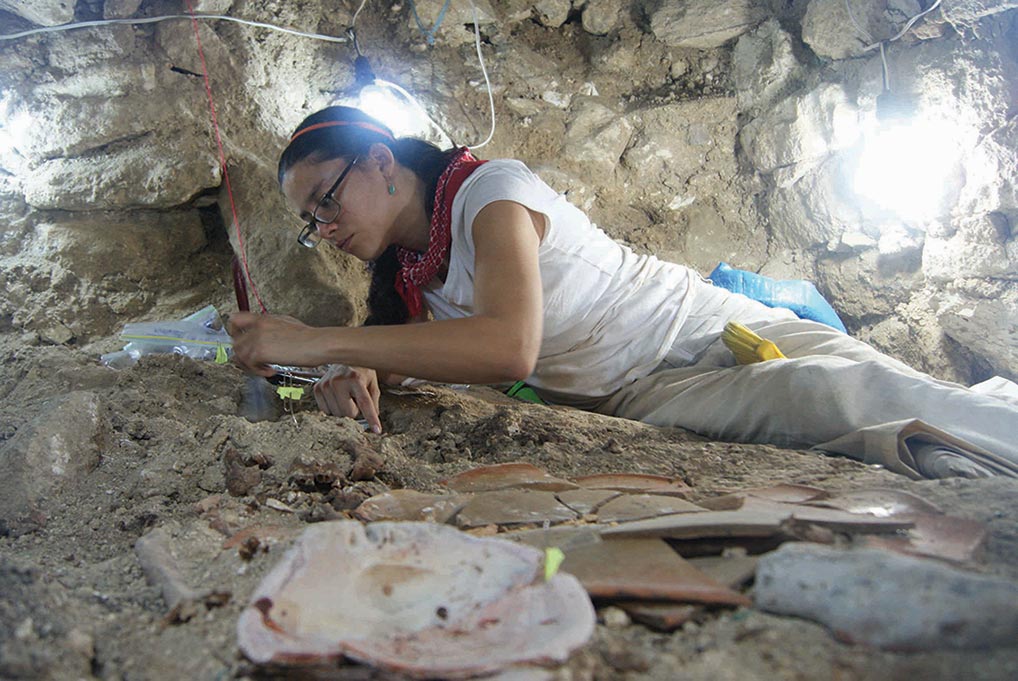
Olivia Navarro-Farr’s Scholarship Featured in First Issue of Feminist Anthropology

WOOSTER, Ohio – The latest scholarship on the contributions of royal Maya women to Classic Period (250-800 A.D.) politics and statecraft from Olivia Navarro-Farr and colleagues is featured in the inaugural publication of Feminist Anthropology. Navarro-Farr serves as the department chair of the archaeology program at The College of Wooster and is also an associate professor in sociology and anthropology, while her co-authors were Mary Kate Kelly, Michelle Rich, and Griselda Pérez Robles.
Navarro-Farr, who has made several prominent discoveries as the co-director of the Guatemalan-U.S. El Perú- Waka’ Archaeological Project, discussed how the role of ancient female rulers, particularly those who represent non-Western cultural traditions, are often unexplored. “These rulers demonstrate great deal of agency that must become more central to our conversations about ancient statecraft. Royal Maya women at this time were deeply involved in these very complicated political relationships and in the expansion of the hegemons they represented. That we may know less about them today is an artifact of presentist bias and is not indicative of the power they actually held in antiquity,” she said.
While the work spans several centuries, much of the focus is on the rise of the Kaan hegemony during the sixth and seventh centuries and the influential Kaloomte’ K’abel, or Lady K’abel, who ruled at Waka’ at this time and whose tomb Navarro-Farr’s team discovered in 2012. In the article, which incorporates scholarship from a critical Black feminist lens, the authors evaluate the complex political system that the Kaan regime innovated during this period and the role of royal Maya women within that system. Specifically, they explore how Lady K’abel and other women contributed to consolidating political power through increased access to trade routes and prowess in war.
Among the fascinating aspects of this political regime, male rulers of subordinate kingdoms were the ones who were “marrying up” with royal Kaan women, like Lady K’abel, according to Navarro-Farr, thus the gender narrative Western society has propagated was flipped. “The titles and status that these royal Maya women possessed were higher than those with whom they intermarried. Rather than being pawns, they were primary agents of these political machinations, ensuring the growth of the Kaan regime. Ancient texts and archaeological evidence reveal how they wielded this persuasive political power,” she remarked.
Lady K’abel’s burial accoutrement and her famous public monument, now housed in the Cleveland Museum of Art, demonstrate that she was a powerful and successful leader and that her status superseded that of her husband. Her burial in the city’s most sacred public ceremonial building indicates that generations of Waka’ peoples continued to revere her memory well after her death.
“Royal women, like K’abel, were central figures whose political importance cannot be understated. We have had the privilege to reencounter her story and to share it widely,” Navarro-Farr commented.
Navarro-Farr notes the importance of elevating these examples of female indigenous leadership, as they are critical for connecting with audiences today, particularly in the current global context.
“We can look at how these different forms of rulership have functioned over time and get beyond the question of whether or not and start asking the ‘how’ questions. How did women contribute to political systems and statecraft in the context of these social and political regimes? How did people organize under their leadership? How did they resolve conflict? How were their cultural worldviews different? There’s an opportunity to learn so much more and give a voice to how these decisions were made,” she said.
The significance of appearing in the first issue of Feminist Anthropology is not lost on Navarro-Farr, calling it a “truly exciting and humbling” achievement. She feels proud of the opportunity to showcase the rich, vibrant Maya civilization and reach a broader audience. “Because our research is informed by the richness of Black feminist theory, we are able to more deftly identify structural inequalities in scholarship and discuss how rectifying these systemic issues permits enhanced research designs and thoughtful questions. This is important for representation and addressing narratives that don’t often get relevance,” she said while also noting that there is still much to learn.
Next spring, Navarro-Farr is planning to return to the archaeological site for fieldwork. She expects the continued excavation of newly-discovered carved hieroglyphic monument will reveal more exciting historical details about this ancient civilization.
Posted in News on July 29, 2020.
Related Posts
Related Areas of Study
Archaeology
Fieldwork and research are a big part of the study of prehistoric and historical archaeology
Major Minor

